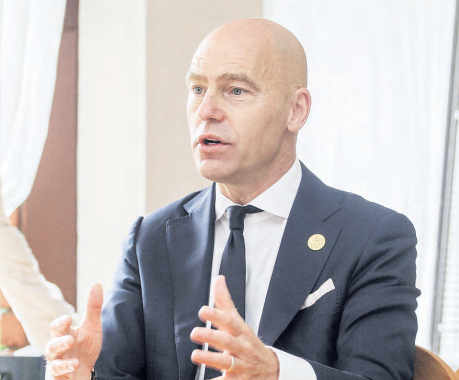

A protracted fight is brewing at the University of Nairobi as its new chancellor pushes through with his ambitious two-year transformation agenda amid mounting resistance by some academic staff.
The institution’s professors’ association has dismissed the reforms as a poorly thought-through blue print that is only after the university’s Sh200 billion lands.
From five broad objectives he calls the “big five” to eight key deliverables that must take root in the next 24 months, Chancellor Patrick Verkooijen is a man on a mission.
He wants to patch up the image of the university akin to the 2003 judicial radical surgery.
Verkooijen told the Star in an exclusive interview that he sees his tenure as a moment to “save the university from a blazing fire”, saying the once institution of academic excellence is on a path to degeneration.
His transformation strategy for 2025-26 has been adopted by the council of the institution and has also been approved by President William Ruto’s Cabinet, giving it the full weight of government endorsement.
However, prof Peter Wasamba, the chairperson of the UoN professors’ association, told the Star that the chancellor is not consultative and they have not seen the document detailing the transformation proposal.
“We only hear that council has adopted it quickly and that the Cabinet has approved it but not a single professor has been briefed on it,” Wasamba said.
“The chancellor is coming down from his ceremonial role to assume executive role and he must understand Kenya and the University of Nairobi very well.”
He said the whole point of Verkooijen’s reforms is the land of the university. “They want to sell university properties and the land in an unaccountable manner. They are using a special purpose vehicle which then cannot be prosecuted once corruption occurs. This is unacceptable.”
Verkooijen’s plan is to institute an asset optimisation masterplan that will include commissioning an independent audit and valuation of all the university’s land.
He says the university has vast prime lands spanning counties and that some will be valued and sold, some leased out and others developed through public-private partnerships as part of generating the billions needed to fund his reform ambitions and clear the Sh20 billion university debts.
“The public debt is choking the university. We will tap into the properties and land of the institution to clear all the debts and settle the numerous court cases to ensure the university is uplifted to the global standard it should be,” Verkooijen said.
“I must emphasise that the process will be transparent and above board because I know the university land is public.”
But the dons remain skeptical of the arrangements. Wasamba, who is the dean of faculty of arts and a professor of African oral literature, says the chancellor has been misguided to believe that the university’s problem is the academic staff and the mode of their work, saying all the blame lies squarely with the management.
“All this drama is top down, and has denied the chancellor, though well meaning, the chance to fully appreciate the reality on the ground. University of Nairobi’s problem is with management, not the teaching fraternity.”
The chancellor’s strategy isolates repeated labour and student unrest, failure by the university management to pay up statutory deductions, mounting debts that have doubled over the last two years, sliding in global ranking, and over 200 legal cases in court as among the problems that is bogging down the university.
Other problems listed in the document shared with the Star include “sub-standard management and representational instruments including the lack of annual report for the previous year by the end of the following year, [and] substandard basic academic services such as poor quality tests and grading.
The chancellor also says the university has been a constant source of controversy throughout last year in the media and Parliament.
The university has been on the
news for the last one year for all the
wrong reasons, ranging from power
struggle pitting council and successive vice-chancellors, to labour row



![[PHOTOS] Ruto at Pope Francis' burial](/_next/image?url=https%3A%2F%2Fcdn.radioafrica.digital%2Fimage%2F2025%2F04%2F844cb891-abd4-4ee5-bc2d-2a0c21fa3983.jpeg&w=3840&q=100)





